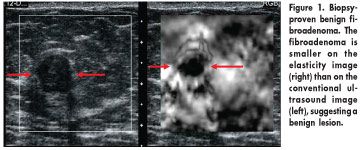Elasticity Imaging Software for Ultrasound Systems Distinguishes Malignant From Benign Breast Lesions
In a new study, elasticity imaging software was highly sensitive and specific when classifying malignant and benign breast lesions
CHICAGOIn a new study, elasticity imaging software was highly sensitive and specific when classifying malignant and benign breast lesions, Richard Barr, MD, PhD, professor of radiology, Northeastern Ohio University College of Medicine, Youngstown, reported at the 92nd Annual Meeting of the Radiological Society of North America (RSNA) (abstract LL-BR4218-B01). The software captures ultrasound frames in real time as they are being collected and characterizes tissue movement to differentiate hard from soft structures.
In the study, lesions were graded as malignant or benign based on the difference in their size on conventional B-mode ultrasound and elasticity imaging. If a lesion was smaller on elasticity imaging than on B-mode ultrasound, it was classified as benign (Figure 1); if larger, it was considered malignant (Figure 2).


Of 80 patients with 123 breast lesions, elasticity imaging correctly predicted all 17 lesions that were malignant at biopsy and 105 of 106 lesions that were benign. The technique had a sensitivity rate of 100%, specificity rate of 99%, positive predictive value of 94%, and negative predictive value of 100%, Dr. Barr said.
May Reduce Unnecessary Biopsies
These early findings suggest that the software, which can be added to conventional ultrasound systems, may significantly reduce the number of biopsies performed each year. Dr. Barr noted that approximately 1.4 million breast biopsies are performed annually, and 80% find only benign masses. "Elasticity imaging may be able to decrease the need for biopsy or additional imaging, including the patient anxiety that is associated with finding new lesions and undergoing a biopsy," he said.
Elasticity imaging also is providing some unique observations about breast lesions, Dr. Barr noted. Cysts, which are seen as thin-walled structures that are free of fluid on conventional ultrasound imaging, have a characteristic bull's eye appearance on elasticity, with white dots inside and posterior to the lesion (see Figure 3).

The technique can also provide other potentially valuable diagnostic information, for example, about lymph nodes. In one case, Dr. Barr said, a lymph node appeared to be normal on conventional ultrasound. On elasticity imaging, however, the lymph node was larger and had a persistently dark area. A biopsy proved that the area was malignant.
Elasticity imaging has been evaluated by other investigators for the last 10 years. It has not been considered to be a very robust diagnostic option, however. The software used by Dr. Barr is an improvement over traditional elasticity programs because it combines real-time ultrasound image acquisition with improved resolution. As a result, elasticity images could be obtained within 1 to 2 minutes and could be used to make a real-time determination of the need for biopsy, he said.
"In the past, you didn't have the results [of elasticity imaging] as you were doing the exam, and you didn't get to see the standard ultrasound image. This new software allows us to see the standard ultrasound image as well as the elastogram at the same time we are doing the exam," Dr. Barr said.
Easy to Perform
Elasticity imaging also was easy to perform. Even when a breast was imaged from several different angles or positions, a malignant lesion always appeared to be larger no matter how it was imaged, Dr. Barr said. He pointed out that the ultrasound technologists who performed the procedure learned to interpret images as well. "Techs can interpret [elasticity scans] just from the experience of watching us. If that can happen, [the technique] should be picked up easily," he commented.
Elasticity imaging software was used in conjunction with an Elegra or Antares ultrasound system from Siemens Medical Solutions. Siemens received 510K clearance from the FDA to begin marketing elasticity imaging software on its ultrasound systems just prior to the RSNA meeting. The software will be commercially available in the first half of 2007, Dr. Barr said.